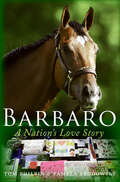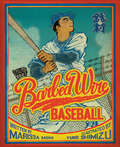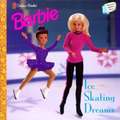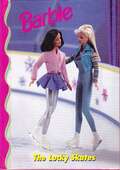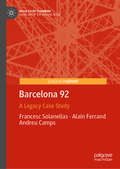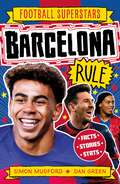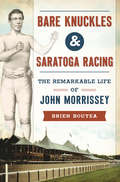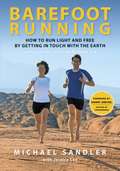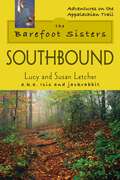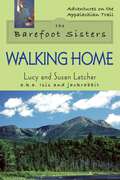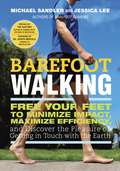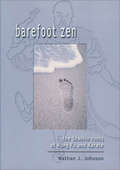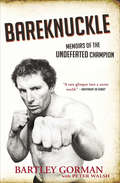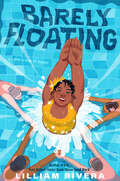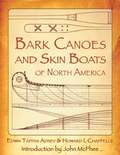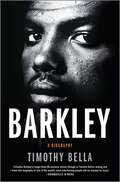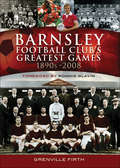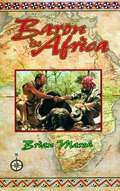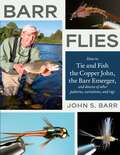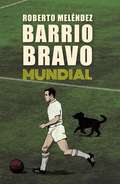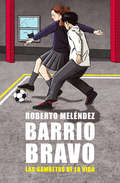- Table View
- List View
Barbaro: A Nation's Love Story
by Tom Philbin Pamela K. BrodowskyThis up-to-minute book follows the story of Barbaro, the Triple Crown contender whose unlikely fight back from almost certain death from a shattered leg and ensuing complications captured the hearts of a nation who responded with a stunning display of love.In 132 years of derby races, only 11 horses have won the Triple Crown, the last in 1978. Barbaro was a favorite to be the twelfth until May 20, 2006, at the Preakness Stakes, when his jockey, Edgar Prado pulled him up a couple of hundred yards from the starting gate. Subsequent examination revealed that he had virtually exploded bones in his right rear leg so badly that under normal conditions he would have been euthanized right on the track. But his owners, Roy and Gretchen Jackson, chose another path, one filled with anxiety and tears—but also courageous determination to save his life. This touching, soaring book—filled with insights from Barbaro's trainers, breeders, caretakers, and owners—follows Barbaro from foal to colt to champion to perfect patient. But In the end it is not just a story of a down-but-not-out champion, but of human beings at their very best.
Barbed Wire Baseball
by Marissa MossAs a boy, Kenichi “Zeni” Zenimura dreams of playing professional baseball, but everyone tells him he is too small. Yet he grows up to be a successful player, playing with Babe Ruth and Lou Gehrig! When the Japanese attack Pearl Harbor in 1941, Zeni and his family are sent to one of ten internment camps where more than 110,000 people of Japanese ancestry are imprisoned without trials. Zeni brings the game of baseball to the camp, along with a sense of hope. This true story, set in a Japanese internment camp during World War II, introduces children to a little-discussed part of American history through Marissa Moss’s rich text and Yuko Shimizu’s beautiful illustrations. The book includes author and illustrator notes, archival photographs, and a bibliography.
Barbie: Ice Skating Dreams
by Diane MuldrowCompetitions can be scary, but Barbie knows just how to help. Join the American icon as she skates to her dreams. Picture descriptions added.
Barbie: The Lucky Skates
by Jacqueline A. BallCoach Barbie is in Paris for the World SuperSkate Championship. Her team's chances of winning look great until her star skater's "lucky" skates disappear. Then it's up to Barbie to unravel the mystery and help her team take home something even better than first place!
Barcelona 92: A Legacy Case Study (Mega Event Planning)
by Francesc Solanellas Alain Ferrand Andreu CampsBarcelona 92: A Legacy Case Study examines the effects of the organisation of Barcelona’s Olympic Games in 1992. Divided into five compelling chapters, the authors discuss issues concerning the definition of legacy, whilst also presenting new models of legacy management and measurement methods, and providing an in-depth examination of sporting, economic and social dimensions. This book offers the most significant studies and research on the 92 Olympics to date, presenting cutting-edge proposals for comparing different Olympic hosting cities into the future.
Barcelona Rule (Football Superstars #30)
by Simon MugfordIn this fun and fact-filled book, Football Superstar's dynamic duo, Dan and Simon tell the story of footballing giants Barcelona, charting the club's amazing history - from its formation by immigrants in 1899 to how it grew into a major European side in the 70s. Then, there was the club's evolution in the 2000s under master coach Pep Guardiola and his talisman Lionel Messi, and of course its lifelong rivalry with real Madrid. Along the way, you'll learn about the other legendary players, managers, matches, the club's lifelong rivalry with Real Madrid and much more that tell the story of the football institution admired around the world. True to the Football Superstars brand, the book is filled with fun cartoons, inspirational stories, a simple narrative style and a cast of characters chipping in with quotes, jokes and comments.
Bare Knuckles & Saratoga Racing: The Remarkable Life of John Morrissey (Sports)
by Brien BouyeaOne of the more dynamic characters of his time, John "Old Smoke" Morrissey made his way from undefeated bare-knuckle boxer to found the Saratoga Race Course and win elections to Congress and the New York State Senate. A poor, uneducated Irish immigrant, Morrissey became a leader in the Dead Rabbits street gang. He won fame as a fighter and fortune as the operator of a string of successful gambling houses. He then took Saratoga Springs by storm. He improbably resurrected thoroughbred racing during the Civil War and opened his famous Club House, the most glamorous casino the country had ever seen. Author Brien Bouyea chronicles the incomparable life of a true American legend.
Barefoot Running: How to Run Light and Free by Getting in Touch with the Earth
by Michael Sandler Jessica LeeHow could something we have for free--our bare feet--be better for running than $150 shoes? The truth is that running in shoes is high-impact, unstable, and inflexible. Shoes promote a heel-centric ground strike, which weakens your feet, knees, and hips, and leads to common running injuries. In contrast, barefoot running is low-impact, forefoot-centric, stable, and beneficial to your body. It encourages proper form and strengthens your feet in miraculous ways. When you run in shoes, you not only risk developing poor form, but you also hinder the natural relationship with the ground that running facilitates. Barefoot running restores the delightful sensory and spiritual connections to the earth that you were meant to experience. Barefoot Running offers the only step-by-step direction runners need at any age to overcome injuries, run faster than ever, and rediscover the pure joy of running. Once you tear off your shoes and learn to dance with nature, you'll tread lightly and freely, hearing only the earth's symphony and feeling only the dirt beneath your feet. Hit the ground running with revolutionary techniques for starting out slowly, choosing minimalist footwear, navigating rough weather and rugged terrain, and building your feet into living shoes.From the Trade Paperback edition.
Barefoot Sisters Southbound (Adventures on the Appalachian Trail)
by Lucy Letcher Susan LetcherSisters Lucy and Susan Letcher begin their barefoot thru-hike of the Appalachian Trail. A story filled with humor and determination.
Barefoot Sisters Walking Home (Adventures on the Appalachian Trail)
by Lucy Letcher Susan LetcherThis second half of the Barefoot Sisters' account has become an AT classic.
Barefoot Walking: Free Your Feet to Minimize Impact, Maximize Efficiency, and Discover the Pleasure of Getting in Touch with the Earth
by Michael Sandler Jessica LeeFrom the authors of Barefoot Running, the essential guide to the life-changing benefits of barefoot walkingAs the thousands of people who have fallen in love with barefoot running already know, shedding your shoes is good for the body and the soul. Barefoot Walking shows all readers, no matter their fitness level, how to take command of their physical and spiritual well-being through this simple and easy practice, even if they are daunted by sore feet, achy joints, injury, illness, or feeling out of shape. This book contains special material for children, pregnant women, and seniors, and shows anyone how this gentle, natural activity can literally transform one's life, restoring health, vitality, strength, and balance, and improving focus, mood, memory, and more. Full of tips and tools for going bare, this is the essential handbook for people who want to move their body, connect with the earth, and feel physically and psychologically more alive.
Barefoot Zen: The Shaolin Roots of Kung Fu and Karate
by Nathan J. JohnsonJohnson makes the Shaolin way legacy accessible to all, releasing the art from the clutches of popular images and painful concerns about self-defense.Barefoot Zen is a brave new approach to the martial arts, which clearly demonstrates that the traditional movements of both Kung Fu and Karate, contained in the solo choreographed sequences of movements known as forms (or kata), grew out of the spiritual practices of the Shaolin order of Buddhist monks and nuns. Nathan Johnson explains that this mystical and non-violent teaching is a profound and beautiful expression of Chan (Zen) Buddhism and its pursuit of wisdom, peace, and enlightenment. Contrary to popular assumption, he contends that it was never intended to be an actual means of self-defense. Barefoot Zen bridges the gap between Kung Fu and Karate, and reveals their common origin through the disclosure of vital research material on three of the world’s most important Karate kata.Part I explains the spiritual disciplines that contributed to what we know as the martial arts. Part II explains the creation of the art along with practical instruction for performing kata. Part III explains the formation of many of the world’s Kung Fu styles.We learn that the original “empty hand art” was used as a method of kinetic meditation between pairs and was designed as a practical tool to assist practitioners in transcending the fear and insecurity of everyday living. The legendary courage of the Shaolin (Chan/Zen) order was not developed by fighting with enemies, but by not fighting!The Shaolin teaching was designed to free us from fear, the only true enemy.
Bareknuckle: Memoirs of the Undefeated Champion
by Peter Walsh Bartley GormanAs bareknuckle fighting is poised to steal MMA&’s spotlight, its greatest modern-day champion tells his story of rising to the top in the brutal sport. Steeped in the tradition of his Irish Traveller ancestry, Bartley Gorman also embraced its dangerous subculture: bareknuckle fighting. Though it gave birth to boxing as we know it today, the sport has remained underground—and illegal in most developed countries. But that didn&’t stop Gorman from rising through the prize-fighting ranks of Great Britain and Ireland and staying undefeated for twenty years. Now, through Gorman&’s thrilling memoir, readers get a front row view of the punches exchanged in back parking lots and fair grounds, the gritty characters populating the fight circles, and the hazards facing a sought after champion. &“A rare glimpse into a secret world,&” Bareknuckle celebrates one man&’s mastery of fighting in its purest form and heralds the rebirth of one of the oldest combat sports in history (The Independent on Sunday). &“Every page shines. A tremendous book.&” —Traveller Magazine &“Well-written and interesting.&” —Boxing News
Barely Floating
by Lilliam RiveraA dazzling story full of heart about how one twelve-year-old channels her rage into synchronized swimming dreams, from the author of The Education of Margot Sanchez and Never Look Back, Lilliam Rivera.Natalia de la Cruz Rivera y Santiago, also known as Nat, was swimming neighborhood kids out of their money at the local Boyle Heights pool when her life changed. The L.A. Mermaids performed, emerging out of the water with matching sequined swimsuits, and it was then that synchronized swimming stole her heart.The problem? Her activist mom and professor dad think it's a sport with too much emphasis on looks—on being thin and white. Nat grew up the youngest in a house full of boys, so she knows how to fight for what she wants, using her anger to fuel her. People often underestimate her swimming skills when they see her stomach rolls, but she knows better than to worry about what people think. Sometimes, she feels more like a submarine than a mermaid, but she wonders if she could be both.Barely Floating explores what it means to sparkle in your skin, build community with those who lift you up, and keep floating when waters get rough.
Bark Canoes and Skin Boats of North America
by Howard I. Chapelle Edwin Tappan Adney John McPheeThe bark canoes of the North American Indians, particularly those of birchbark, were among the most highly developed manually propelled primitive watercraft. Built with Stone Age tools from available materials, their design, size, and appearance were varied to suit the many requirements of their users. Even today, canoes are based on these ancient designs, and this fascinating guide combines historical background with instructions for constructing one. Author Edwin Tappan Adney, born in 1868, devoted his life to studying canoes and was practically the sole scholar in his field. His papers and research have been assembled by a curator at the Smithsonian Institution.
Barkley: A Biography
by Timothy BellaThe definitive biography of Charles Barkley, exploring his early childhood, his storied NBA career, and his enduring legacy as a provocative voice in American pop culture He&’s one of the most interesting American athletes in the past fifty years. Passionate, candid, iconoclastic, and gifted both on and off the court, Charles Barkley has made a lasting impact on not only the world of basketball but pop culture at large. Yet few people know the real Charles. Raised by his mother and grandmother in Leeds, Alabama, he struggled in his early years to fit in until he found a sense of community and purpose in basketball. In the NBA he went toe-to-toe with the biggest legends in the game, from Magic to Michael to Hakeem to Shaq. But in the years since, he has become a bold agitator for social change, unafraid to grapple, often brashly, with even the thorniest of cultural issues facing our nation today. Informed by over 370 original interviews and painstaking research, Timothy Bella&’s Barkley is the most comprehensive biography to date of one of the most talked-about icons in the world of sports.
Barney Ross: The Life of a Jewish Fighter (Jewish Encounters Series)
by Douglas CenturyBorn Dov-Ber Rasofsky to Eastern European immigrant parents, Barney Ross grew up in a tough Chicago neighborhood and witnessed his father's murder, his mother's nervous breakdown, and the dispatching of his three younger siblings to an orphanage, all before he turned fourteen. To make enough money to reunite the family, Ross became a petty thief, a gambler, a messenger boy for Al Capone, and, eventually, an amateur boxer. Turning professional at nineteen, he would capture the lightweight, junior welterweight, and welterweight titles over the course of a ten-year career.Ross began his career as the scrappy "Jew kid," ended it as an American sports icon, and went on to become a hero during World War II, earning a Silver Star for his heroic actions at Guadalcanal. While recovering from war wounds and malaria he became addicted to morphine, but with fierce effort he ultimately kicked his habit and then campaigned fervently against drug abuse. And the fighter who brought his father's religious books to training camp also retained powerful ties to the world from which he came. Ross worked for the creation of a Jewish state, running guns to Palestine and offering to lead a brigade of Jewish American war veterans. This first biography of one of the most colorful boxers of the twentieth century is a galvanizing account of an emblematic life: a revelation of both an extraordinary athlete and a remarkable man.From the Hardcover edition.
Barnsley Football Club's Greatest Games, 1890s–2008
by Grenville FirthA variety of games spanning the entire history of Barnsley Football Club, from its origins as Barnsley St Peters to the present-day. Over 50 matches are included, from 4,600 fixtures. They include 2 FA Cup FInals, Semi-FInals, recent cup triumphs against Liverpool at Anfield and Chelsea at Oakwell, the recent new Wembley experience and the last play-off at the Millennium Stadium. Also included is the historic game against Bradford City after which Barnsley obtained promotion to the Premier League. Apart from a summary report, reference is also made to post-match comments from managers and players. The reason for inclusion of a particular match varies according to several key factors. It might be a notable FA Cup game against formidable opponents, maybe a key battle that resulted in promotion, a spectacular score line or even a fixture in which the brilliance of one or more players was exceptional. From the latter, examples include Frank Eatons first ever five goals in one match, the great Tommy Taylors hat-trick in only his second appearance for the club and a brilliant individual performance by Arthur Kaye. Also included are several famous games in which the players performed exceptionally well even in the face of defeat.
Baron in Africa: The Remarkable Adventures of Werner Von Alvensleben
by Brian MarshWerner von Alvensleben comes from a long line of German aristocrats. Yet far from enjoying a privileged and pampered existence, his life plays like a Hollywood adventure movie. Imprisoned in Zimbabwe during World War II, von Alvensleben escaped by digging underneath an electric fence in the rain and making his way by foot to Mozambique.After founding the famous Safarilandia hunting company, he guided a list of hunting luminaries that included Jack O'Connor and Robert Ruark (who found out he could not bribe Werner!). Follow his career as he attacks a man-eating lion, kills a full-grown buffalo with a spear, and hunts for elephant and ivory in some of the densest brush in Africa. Adventure and experience were what counted to the man they call "Baron," not money or fame; indeed, in the end he left Mozambique with barely more than the clothes on his back.
Barr Flies: How to Tie and Fish the Copper John, the Barr Emerger, and Dozens of Other Patterns, Variations, and Rigs
by John S. BarrBarr is the most successful designer of commercially distributed flies in the world. The Barr Emerger is an unrivaled pattern for western mayfly situations, and the Copper John has evolved into the most popular fly of the millennium. Learn Barr's methods for tying his favorite flies, with step-by-step instructions and clear color photos so even inexperienced tiers can create the Copper John, Barr Emerger, B/C Hopper, Tung Teaser, Slumpbuster, and more.
Barracuda (The Seven Prequels #6)
by Sigmund BrouwerFishing for barracuda from a kayak in the Florida Keys. That's what Jim Webb thinks this resort vacation with his grandfather should be about. Except the dying resort owner holds the key to legend about a generations-old crime. A crime that is worth way too much to those who want the legend to be true. Webb soon discovers that what lurks in the sun, sand and shallow waters of the Keys is much more dangerous than a slashing game fish. And along the way, he learns an important truth about himself and his own past. In this exciting prequel to Devil's Pass and Tin Soldier, the musically gifted and tenacious Webb finds himself caught in a dangerous mystery.
Barrel Racing 101: A Complete Program For Horse And Rider
by Marlene McraeFew equestrian sports are more exciting than barrel racing, in which horse and rider carve a lightning-fast cloverleaf pattern around three barrels, then gallop down to the finish line. Time is measured in hundredths of seconds, and winners receive substantial prize money and the admiration and respect of fellow competitors and spectators alike.As thrilling as barrel racing is to watch, doing it is even more fun, as thousands of people are discovering every year. To help them--and you--get started, champion racer and internationally respected instructor and clinician Marlene McRae shares her program that has taken hundreds of her students to success in the arena, as well as to becoming educated horsemen and-women:* Selecting Your Champion Horse: Choosing a barrel-racing prospect based on conformation and temperament; finding a qualified veterinarian to help you assess the prospects.* Choosing and Using Equipment: Determining the right saddle, bridle (including bits), leg protection, and other tack to buy, as well as their proper fit and use.* Feeding and Nutrition: Establishing a basic commonsense feeding regimen for your horse; the role of supplements, as well as their possible misuse.* Shoeing and Foot Care: Proper foot care, with an emphasis on working with your farrier and veterinarian to avoid foot- and leg-related injuries.* Conditioning and Exercising: A comprehensive program for developing your horse's stamina and fitness, along with ways to avoid unsoundness problems.* Getting Started in the Barrel-Racing Patterns: How to set up the pattern correctly; techniques for training the horse, with an emphasis on rider position, balance, and using hands, legs, and voice as communication aids.* Competing: Locating entry-level local events, clubs, and associations; the "mental game of competing to stay focused; achieving teamwork with your horse."Barrel Racing 101 is the perfect textbook for the sport. Study it and use it, and you're bound to finish at the top of your class.
Barrio Bravo
by Roberto MelendezBarrio Bravo: el fenómeno futbolístico de las redes sociales ¿Qué tiene que ver la historia del Quisco, un joven futbolista amateur, con los superjugadores Ronaldo o Totti? ¿En qué se relaciona la semifinal entre Universidad Católica de Rinconada de Los Andes y Ferro Llanquihue, con la final de la Copa América? ¿O los pormenores del Torneo de los Recreos con la revancha de un amor despechado con Marcelo Bielsa? La pasión por el fútbol es lo que une, en este libro magistralmente escrito, estas y otras historias épicas, que nos llevan a vivir el ritual de la cancha, el vitoreo de la hinchada y las gambetas de la vida misma.
Barrio Bravo Mundial
by Roberto Melendez<P>Un conjunto de relatos ambientados en las diversas copas del mundo Por estas páginas desfilan Pelé, Maradona, Baggio, Ronaldo, Zidane y Suárez; pero también hay espacio #entre diversos personajes# para una futbolista de Nigeria, una monja fanática de la selección chilena, un delantero austriaco que se negó a jugar por la Alemania Nazi y un defensa africano que salvó la vida de sus compañeros. <P>Barrio Bravo Mundial es una fotografía magistral de las grandes hazañas peloteras y, al mismo tiempo, un homenaje a los héroes anónimos detrás del espectáculo. Una obra adictiva y épica. Un regreso que confirma al autor como uno de los narradores de fútbol más rutilantes del momento.
Barrio bravo: Las gambetas de la vida
by Roberto MelendezUn nuevo compilado de relatos del narrador de fútbol más deslumbrante del momento Luego del fenómeno de sus dos entregas anteriores, Roberto Meléndez entrega nuevamente una serie de historias que se bifurcan al disputarse una pelota. Diversos escenarios #el Olímpico de Roma o el patio del colegio# donde florece la distinguible frescura de un autor aplaudido por miles de lectores en Chile e Hispanoamérica. En Las gambetas de la vida las sombras del estadio son tan entrañables como las luces. Los héroes tocan el cielo y también se azotan. La pelota corre, a veces se pincha, pero nunca se mancha. Y es que en el equipo de Barrio Bravo, las grandes estrellas hacen una pared con hombres y mujeres anónimas hasta reír y llorar en el abrazo de gol: ese universo tan difícil de explicar y dimensionar.
